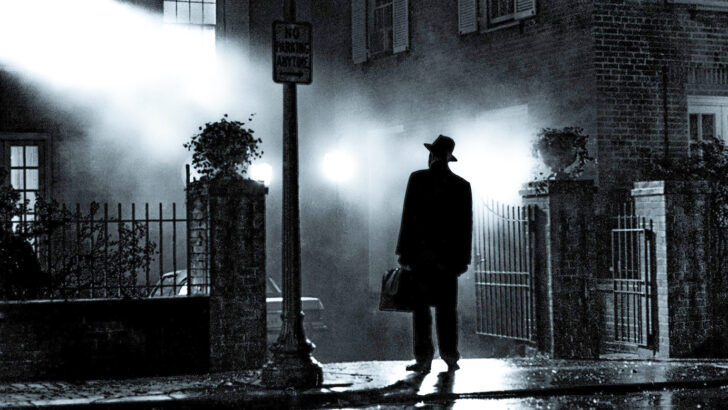The Church understands that demonic possession is very rare, writes David Quinn
The most famous horror movie ever made is probably The Exorcist, which was released in 1973 causing a worldwide sensation and drawing huge crowds to watch it. The director of the movie, William Friedkin, died last week aged 87.
Mr Friedkin himself was not sure whether demonic possession was a real thing or not and seems to have been broadly religiously agnostic in his views, but not hostile. He was open-minded about religious phenomena.
The Exorcist
To this day, The Exorcist is regarded as a terrifying movie, even though it has been imitated countless times since in various ways. But its shock value when it first came out 50 years ago cannot be underestimated.
Up to that time, most horror movies were very tame by comparison. Audiences were accustomed to Dracula and Frankenstein movies starring actors such as Christopher Lee and Boris Karloff. We wanted to be mildly scared but not terrified out of our wits. We look back on those movies now and wonder how anyone found them in the least creepy.
Movies about the devil were rare. There was one called The Devil Rides Out from the Hammer Horror studio released in 1968 and starring Christopher Lee. But it was a tame if entertaining enough fare.
That same year, the famous movie director, Roman Polanski, released Rosemary’s Baby which was far creepier and unnerving.
But then, five years later, The Exorcist hit movie screens and turned up the level of horror enormously.
The film is based on a book of the same name written two years previously by William Blatty and which centres on an 11-year-old girl named Regan MacNeill.
Mr Blatty apparently drew on a real-life case from 1949 involving a boy roughly the same age as the fictional Regan.
Possession
Both the book, and especially the movie, massively dramatised what is involved in an exorcism and what the symptoms of demonic possession are. We see Regan levitate, her head spins, her face becomes demonic, she walks spider-like downstairs, she speaks in a demonic voice, objects are hurled across rooms by supernatural forces.
All of this was horrifying to audiences, and The Exorcist still holds its own against modern horror movies as a genuinely unsettling experience.
But how does the movie version of demonic possession and exorcism compare with how the Church sees them?
The first place to go looking for a comparison is the Bible itself, and the gospels in particular.
The most striking description of demonic possession is found in Mark, chapter five which speaks of how a man with an “impure spirit” came to speak to Jesus.
Mark tells us: “This man lived in the tombs, and no one could bind him anymore, not even with a chain. For he had often been chained hand and foot, but he tore the chains apart and broke the irons on his feet. No one was strong enough to subdue him. Night and day among the tombs and in the hills he would cry out and cut himself with stones.”
When the man approaches Jesus, Jesus asks him for his name, and he replies “Legion, for we are many”.
Jesus orders the legion of demons out of him and into a nearby herd of pigs that go to their deaths by dashing down a steep bank and into a lake where they drowned.
But notice what is missing from this account, and all other descriptions of demonic possession in the gospels compared with the movie. There is no head spinning, no levitation, no spider-walks, no objects being hurled across rooms by supernatural forces.
Demons speaking
Demons do speak out of the possessed person, this is the only thing that the movie version of possession, and what we see in the gospels, have in common.
Therefore, when you think about this issue have the gospels in mind, not the movies.
Mr Friedkin himself would remind people in interviews not to take his movie overly literally.
One of those interviews took place after he made a documentary featuring the famed Italian exorcist, Fr Gabriele Amorth, who died in 2016 aged 91.
Fr Amorth allowed Mr Friedkin to accompany him to an attempted exorcism ceremony involving an Italian woman who was seemingly possessed for years. None of the supernatural events depicted in the movies take place, apart from one, namely an utterly inhuman voice emerges from her.
This is more in keeping with demonic possession as it is described in the gospels.
People are also inclined because of the movies to believe there is one dramatic moment when a person is freed from demonic possession, but this does not appear to be the case. Often the exorcist will have to return again and again to perform the ceremony and pray over the person.
Why is this, especially when we consider that Jesus could instantly expel a demon and ordered his disciples to do the same in his name?
I think there are a couple of reasons. One is that an exorcist should be a priest of exceptional holiness and how many such priests exist in the real world? There are plenty of good priests, but how many are truly holy?
William Friedkin says in an interview that Fr Amorth was, in his view, “profoundly spiritual”.
A second reason is that an exorcism is not a Sacrament. It is in a different category. A Sacrament involves a change in our state of being, for example, a couple who marry in the eyes of the Church are now married forever. A priest is a priest forever, even if he can be released from his vows.
Praying
An exorcism is more like praying for someone. It might work, or it might not. One reason we ask particularly prayerful people to pray for us is because we imagine (rightly) that such people are closer to God than the rest of us.
This is also why particularly prayerful priests are the ones appointed by bishops to officially perform exorcisms in their dioceses.
Fortunately, possession is exceptionally rare, and many dioceses therefore don’t have official exorcists at all. I once spoke to a priest (he died a number of years ago), who investigated possible cases of possession in Dublin archdiocese, and he said he never came across a genuine one.
And if they are extremely rare, they are never as depicted in the movies. The Exorcist, effective though it might be as a horror movie, is ultimately very Hollywood and highly fictionalised and sensationalised. Take it with a big grain of salt.


 David Quinn
David Quinn A scene from 'The Exorcist' (1973).
A scene from 'The Exorcist' (1973).